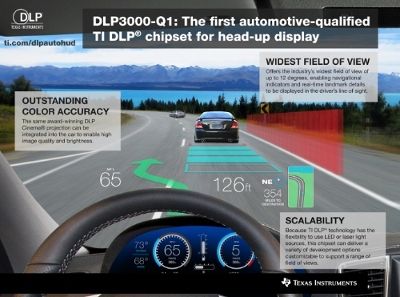Chipset brings the flexibility and color accuracy of award-winning DLP Cinema® DMD to windshields
 Bangalore, 16th April 2015 — Texas Instruments (TI) introduced the first DLP® chipset engineered and qualified for automotive head-up display (HUD) applications. Combining the award-winning imaging qualities of DLP technology with automotive reliability, the new chipset enables head-up displays with the industry’s widest field of view (FOV) up to 12 degrees. It also enables high brightness, color and contrast levels and provides manufacturers with a scalable platform. For more information, see www.ti.com/headupdisplay.
Bangalore, 16th April 2015 — Texas Instruments (TI) introduced the first DLP® chipset engineered and qualified for automotive head-up display (HUD) applications. Combining the award-winning imaging qualities of DLP technology with automotive reliability, the new chipset enables head-up displays with the industry’s widest field of view (FOV) up to 12 degrees. It also enables high brightness, color and contrast levels and provides manufacturers with a scalable platform. For more information, see www.ti.com/headupdisplay.
The DLP3000-Q1 chipset consists of a DLP 0.3-inch wide video graphics array (WVGA) digital micromirror device (DMD) and DLPC120 controller and enables a new generation of HUD with benefits that include:
The widest FOV in the industry:
- The flexibility of the DLP3000-Q1 allows for the industry’s widest FOV HUD range, up to 12 degrees. A wide FOV HUD of this range allows augmented-reality elements such as navigational indicators and real-time landmark details to be displayed in the driver’s line of sight – with a depth perception of 2 to 20 meters ahead – to help keep the driver focused on the road.
Outstanding brightness, dynamic range and color accuracy:
- A HUD based on the DLP3000-Q1 features the same core technology that powers more than eight out of 10 digital movie theater screens worldwide. This results in a HUD capable of producing 15,000 candela per square meters (cd/m2) of brightness, a dynamic dimming range of 5,000:1, high contrast >1,000:1 full on/full off (FOFO) and 125 percent National Television System Committee (NTSC) color-gamut performance that will not degrade over temperature for clear images in various viewing scenarios over the typical life of the vehicle.
- In addition, DLP technology does not require polarization of light which helps automotive original equipment manufacturers (OEMs) design in HUDs with displays that are visible while wearing polarized eye-wear.
Scalability:
- Because DLP technology is light source-agnostic, it can leverage reliable light-emitting diodes (LEDs) while providing a future path to using lasers once they are available for automotive-qualified HUD applications.
- In addition, with the DLP3000-Q1 as the core component of the HUD picture generation unit (PGU), the whole system can be integrated into a variety of mechanical form factors such as a windshield or combiner HUDs. This is possible, across vehicle model lines, potentially resulting in greater returns on manufacturers’ investments.
To accelerate end-product development, TI maintains an extensive ecosystem of design houses. The DLP Design Network provides developers a diverse network to support their hardware and software integration, optics design, system integration, prototyping, manufacturing services, and turnkey solutions to support current and evolving customer needs.






